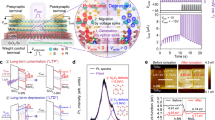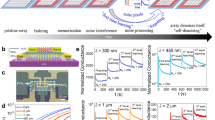Abstract
Neurochip based on light-addressable potentiometric sensor (LAPS), whose sensing elements are excitable cells, can monitor electrophysiological properties of cultured neuron networks with cellular signals well analyzed. Here we report a kind of neurochip with rat pheochromocytoma (PC12) cells hybrid with LAPS and a method of de-noising signals based on wavelet transform. Cells were cultured on LAPS for several days to form networks, and we then used LAPS system to detect the extracellular potentials with signals de-noised according to decomposition in the time-frequency space. The signal was decomposed into various scales, and coefficients were processed based on the properties of each layer. At last, signal was reconstructed based on the new coefficients. The results show that after de-noising, baseline drift is removed and signal-to-noise ratio is increased. It suggests that the neurochip of PC12 cells coupled to LAPS is stable and suitable for long-term and non-invasive measurement of cell electrophysiological properties with wavelet transform, taking advantage of its time-frequency localization analysis to reduce noise.
Similar content being viewed by others
References
Artursson, T., Holmberg, M., 2002. Wavelet transform of electronic tongue data. Sens. Actuators B: Chem., 87(2):379–391. [doi:10.1016/S0925-4005(02)00270-8]
Bousse, L., 1996. Whole cell biosensors. Sens. Actuators B: Chem., 34(1–3):270–275. [doi:10.1016/S0925-4005(96)01906-5]
Chalfie, M., Perlman, R.L., 1976. Studies of a transplantable rat pheochromocytoma: biochemical characterization and catecholamine secretion. J. Pharmacol. Exp. Ther., 197(3):615–622.
Fanigliulo, A., Accossato, P., Adami, M., Lanzi, M., Martinoia, S., Paddeu, S., Parodi, M.T., Rossi, A., Sartore, M., Grattarola, M., et al., 1996. Comparison between a LAPS and an FET-based sensor for cell-metabolism detection. Sens. Actuators B: Chem., 32(1):41–48. [doi:10.1016/0925-4005(96)80107-9]
Fromherz, P., 2003. Semiconductor chips with ion channels, nerve cells and brain. Physica E, 16(1):24–34. [doi:10.1016/S1386-9477(02)00578-7]
Fromherz, P., Offenhausser, A., Vetter, T., Weis, J., 1991. A neuron-silicon junction: a retzius cell of the leech on an insulated-gate field effect transistor. Science, 252(5010):1290–1293. [doi:10.1126/science.1925540]
Gilchrist, K.H., Giovangrandi, L., Whittington, R.H., Kovacs, G.T.A., 2005. Sensitivity of cell-based biosensors to environmental variables. Biosens. Bioelectron., 20(7):1397–1406. [doi:10.1016/j.bios.2004.06.007]
Greene, L.A., Tischler, A.S., 1976. Establishment of a noradrenergic clonal line of rat adrenal pheochromocytoma cells which respond to nerve growth factor. Proc. Natl. Acad. Sci. USA, 73(7):2424–2428. [doi:10.1073/pnas.73.7.2424]
Hafeman, D.G., Parce, J.W., McConnell, H.M., 1988. Light-addressable potentiometric sensor for biochemical systems. Science, 240(4856):1182–1185. [doi:10.1126/science.3375810]
Hassenklöver, T., Predehl, S., Pilli, J., Ledwolorz, J., Assmann, M., Bickmeyer, U., 2006. Bromophenols, both present in marine organisms and in industrial flame retardants, disturb cellular Ca2+ signaling in neuroendocrine cells (PC12). Aquat. Toxicol., 76(1):37–45. [doi:10.1016/j.aquatox.2005.09.004]
Hegg, C.C., Miletic, V., 1996. Acute exposure to inorganic lead modifies high-threshold voltage-gated calcium currents in rat PC12 cells. Brain Res., 738(2):333–336. [doi:10.1016/S0006-8993(96)00999-7]
Hodgkin, A.L., Huxley, A.F., 1952. A quantitative description of membrane current and its application to conduction and excitation in never. J. Physiol., 117:500–544.
Huys, R., Braeken, D., van Meerbergen, B., Winters, K., Eberle, W., Loo, J., Tsvetanova, D., Chen, C., Severi, S., Yitzchaik, S., et al., 2008. Novel concepts for improved communication between nerve cells and silicon electronic devices. Solid State Electron., 52(4):533–539. [doi:10.1016/j.sse.2007.10.025]
Ismail, A.B., Yoshinobu, T., Iwasaki, H., Sugihara, H., Yukimasa, T., Hirata, I., Iwata, H., 2003. Investigation on light-addressable potentiometric sensor as a possible cell-semiconductor hybrid. Biosens. Bioelectron., 18(12):1509–1514. [doi:10.1016/S0956-5663(03)00129-5]
Kovacs, G.T.A., 2003. Electronic sensors with living cellular components. Proc. IEEE, 91(6):915–929. [doi:10.1109/JPROC.2003.813580]
Liu, Q., Cai, H., Xu, Y., Li, Y., Li, R., Wang, P., 2006. Olfactory cell-based biosensor: a first step towards a neurochip of bioelectronic nose. Biosens. Bioelectron., 22(2):318–322. [doi:10.1016/j.bios.2006.01.016]
Liu, Q., Yu, J., Huang, H., Cai, H., Xu, Y., Li, Y., Li, R., Wang, P., 2007. Embryonic stem cells as a novel cell source of cell-based biosensor. Biosens. Bioelectron., 22(6):810–815. [doi:10.1016/j.bios.2006.03.006]
Maher, M.P., Pine, J., Wright, J., Tai, Y.C., 1999. The neurochip: a new multielectrode device for stimulation and recording from cultured neurons. J. Neurosci. Meth., 87(1):45–56. [doi:10.1016/S0165-0270(98)00156-3]
Manganiello, L., Vega, C., Ros, A., Valcarcel, M., 2002. Use of wavelet transform to enhance piezoelectric signals for analytical purposes. Anal. Chim. Acta, 456(1):93–103. [doi:10.1016/S0003-2670(02)00009-0]
Nakagawa, S., Yamamoto, K., 1997. Speech recognition using hidden Markov models based on segmental statistics. Syst. Comput. Jpn, 28(7):31–38. [doi:10.1002/(SICI)1520-684X(19970630)28:7<31::AID-SCJ4>3.3.CO;2-O]
Neher, E., 2001. Molecular biology meets microelectronics. Nat. Biotechnol., 19(2):114. [doi:10.1038/84359]
Pancrazio, J.J., Whelan, J.P., Borkholder, D.A., Ma, W., Stenger, D.A., 1999. Development and application of cell-based biosensors. Ann. Biomed. Eng., 27(6):697–711. [doi:10.1114/1.225]
Parak, W.J., George, M., Domke, J., Radmacher, M., Behrends, J.C., Denyer, M.C., Gaub, H.E., 2000. Can the light-addressable potentiometric sensor (LAPS) detect extracellular potentials of cardiac myocytes? IEEE. Trans. Biomed. Eng., 47(8):1106–1113. [doi:10.1109/10.855939]
Sardy, S., Tseng, P., Bruce, A., 2001. Robust wavelet denoising. IEEE Trans. Signal Process., 49(6):1146–1152. [doi:10.1109/78.923297]
Slaughter, G., Hobson, R.S., 2009. An impedimetric biosensor based on PC12 cells for the monitoring of exogenous agents. Biosens. Bioelectron., 24(5):1153–1158. [doi:10.1016/j.bios.2008.06.060]
Stein, B., George, M., Gaub, H.E., Parak, W.J., 2004. Extracellular measurements of averaged ionic currents with the light-addressable potentiometric sensor (LAPS). Sens. Actuators B: Chem., 98(2–3):299–304. [doi:10.1016/j.snb.2003.10.034]
Stenger, D.A., Gross, G.W., Keefer, E.W., Shaffer, K.M., Andreadis, J.D., Ma, W., Pancrazio, J.J., 2001. Detection of physiologically active compounds using cell-based biosensors. Trends Biotechnol., 19(8):304–309. [doi:10.1016/S0167-7799(01)01690-0]
Wang, P., Liu, Q., 2009. Cell-based Biosensors: Principles and Applications. Artech House Publisher, Norwood, MA, USA, p.1–10.
Wang, P., Xu, G., Qin, L., Xu, Y., Li, Y., Li, R., 2005. Cell-based biosensors and its application in biomedicine. Sens. Actuators B: Chem., 108(1–2):576–584. [doi:10.1016/j.snb.2004.11.056]
Xu, G., Ye, X., Qin, L., Xu, Y., Li, Y., Li, R., Wang, P., 2005. Cell-based biosensors based on light-addressable potentiometric sensors for single cell monitoring. Biosens. Bioelectron., 20(9):1757–1763. [doi:10.1016/j.bios.2004.06.037]
Zhu, K., Wong, Y.S., Hong, G.S., 2009. Wavelet analysis of sensor signals for tool condition monitoring: a review and some new results. Int. J. Mach. Tool. Manu., 49(7–8):537–553. [doi:10.1016/j.ijmachtools.2009.02.003]
Author information
Authors and Affiliations
Corresponding author
Additional information
Project supported by the National Natural Science Foundation of China (Nos. 30700167 and 60725102), the Project of State Key Laboratory of Transducer Technology of China (No. SKT0702), the Zhejiang Provincial Natural Science Foundation of China (No. Y2080673), and the Scientific Research Fund of the Education Department of Zhejiang Province, China (No. Y200909323)
Rights and permissions
About this article
Cite this article
Liu, Qj., Ye, Ww., Yu, H. et al. Neurochip based on light-addressable potentiometric sensor with wavelet transform de-noising. J. Zhejiang Univ. Sci. B 11, 323–331 (2010). https://doi.org/10.1631/jzus.B0900349
Received:
Accepted:
Published:
Issue Date:
DOI: https://doi.org/10.1631/jzus.B0900349




